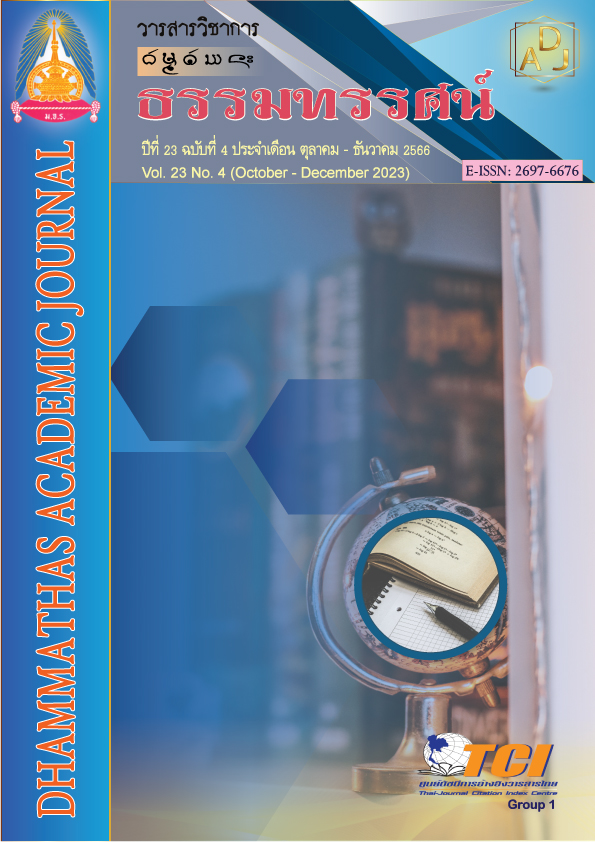The Behaviorof Foreign Tourists and Cultural Tourism Phuket
Main Article Content
Abstract
This research aims to achieve two primary objectives: 1) to study the level of opinions and 2) to investigate the behavior of foreign tourists regarding cultural tourism in Phuket province. The research adopts a quantitative approach, utilizing a sample group comprising 50 foreign tourists who visited Phuket. The research tool employed is a questionnaire administered through Google Form, and statistical analysis includes mean, frequency, standard deviation, and multiple regression analysis.
The research findings reveal the following:
1. Tourists' opinions are correlated with various variables such as gender, age, education level, occupation, work experience, and average monthly income. The statistical significance level is set at 0.05, and the results are reliable at a confidence level of 73.25%, enabling the prediction and forecasting of the travel behavior of foreign tourists in Phuket.
2. The behavior of foreign tourists regarding cultural tourism in Phuket suggests a direction in creating tourist destinations related to local culture, such as local museums and cultural villages like Koh Raya Village. This is aimed at enhancing unique and creative tourism experiences for visitors seeking to immerse themselves in the local culture. Additionally, Phuket province is actively conserving and promoting the utilization of cultural architecture and local landmarks to provide tourists with distinctive travel experiences. The results of this research have the potential to stimulate the development of tourist destinations and cultural tourism in Phuket in the future.
Article Details

This work is licensed under a Creative Commons Attribution-NonCommercial-NoDerivatives 4.0 International License.
เพื่อให้เป็นไปตามกฎหมายลิขสิทธิ์ ผู้นิพนธ์ทุกท่านต้องลงลายมือชื่อในแบบฟอร์มใบมอบลิขสิทธิ์บทความ ให้แก่วารสารฯ พร้อมกับบทความต้นฉบับที่ได้แก้ไขครั้งสุดท้าย นอกจากนี้ ผู้นิพนธ์ทุกท่านต้องยืนยันว่าบทความ ต้นฉบับที่ส่งมาตีพิมพ์นั้น ได้ส่งมาตีพิมพ์เฉพาะในวารสาร วิชาการธรรม ทรรศน์ เพียงแห่งเดียวเท่านั้น หากมีการใช้ ภาพหรือตารางของผู้นิพนธ์อื่นที่ปรากฏในสิ่งตีพิมพ์อื่นมาแล้ว ผู้นิพนธ์ต้องขออนุญาตเจ้าของลิขสิทธิ์ก่อน พร้อมทั้ง แสดงหนังสือที่ได้รับการยินยอมต่อบรรณาธิการ ก่อนที่บทความจะได้รับการตีพิมพ์References
กาญจนา แสงลิ้มสุวรรณ และศรันยา แสงลิ้มสุวรรณ. (2555). การท่องเที่ยวเชิงมรดกวัฒนธรรมอย่างยั่งยืน. กรุงเทพฯ: มหาวิทยาลัยกรุงเทพ.
เชาวรัตน์ อรอมรรัตน์. (2561). พฤติกรรมการใช้พื้นที่รอบองค์พระปฐมเจดีย์ จังหวัดนครปฐม. วารสารสาระศาสตร์, 2(2561), 194-207.
ธัมมามนตร์ คุณรัตนากรณ์ และคณะ. (2557). อิทธิพลของส่วนประสมการตลาด และภาพลักษณ์ของผลิตภัณฑ์การท่องเที่ยวเชิงวัฒนธรรมที่มีต่อความภักดีในการท่องเที่ยวเพื่อเรียนรู้วัฒนธรรมไทยของนักท่องเที่ยวชาวต่างชาติ. วารสารดุษฎีบัณฑิตทางสังคมศาสตร์ คณะมนุษยศาสตร์และสังคมศาสตร์, 4(3), 100-117.
นุชนารถ รัตนสุวงศ์ชัย. (2554). กลยุทธ์การพัฒนาการท่องเที่ยวเชิงวัฒนธรรม. วารสารมนุษยศาสตร์วิชาการคณะมนุษยศาสตร์ มหาวิทยาลัยเกษตรศาสตร์, 18(1), 31-50.
บุญชม ศรีสะอาด. (2553). การวิจัยเบื้องต้น. กรุงเทพฯ: สุวีริยาสาส์น.
ปิ่นฤทัย คงทอง และสุวารี นามวงศ์. (2559). ปัจจัยที่ส่งผลต่อความสำเร็จของการพัฒนาแหล่งท่องเที่ยวเชิงวัฒนธรรมของจังหวัดนครศรีธรรมราช. วารสารวิชาการการท่องเที่ยวไทยนานาชาติ, 12(2), 1-32.
สมสกุล จีระศิลป์. (2555). การศึกษารูปแบบสถาปัตยกรรมและลวดลายประดับสถาปัตยกรรมชิโนโปรตุกิสเพื่อสร้างสรรค์การออกแบบผลิตภัณฑ์ของที่ระลึกจังหวัดภูเก็ต. (รายงานการวิจัย). กรุงเทพฯ: มหาวิทยาลัยราชภัฎสวนสุนันทา.
สวัสดิ์ เฉิดจิ้ม, สมกมล ภัทรกิจโสภณ และศิรินภา ขาวผ่องอำไพ. (2557). การพัฒนารูปแบบการท่องเที่ยวเชิงวัฒนธรรมลุ่มน้ำนครชัยศรี. Life Sciences and Environment Journal, 15(2), 125-132.
สุดแดน วิสุทธิลักษณ์. (2558). องค์ความรู้ว่าด้วยการท่องเที่ยวเชิงสร้างสรรค์: คู่มือและแนวทางปฏิบัติ. กรุงเทพฯ: องค์การบริหารการพัฒนาพื้นที่พิเศษเพื่อการท่องเที่ยวอย่างยั่งยืน (องค์การมหาชน).
สุดาพร ทองสวัสดิ์. (2559). พฤติกรรมและความพึงพอใจของนักท่องเที่ยวชาวมาเลเซียต่อการท่องเที่ยวเชิงวัฒนธรรมในจังหวัดสงขลา. วารสารปัญญาภิวัฒน์, 8(3), 112-121.

